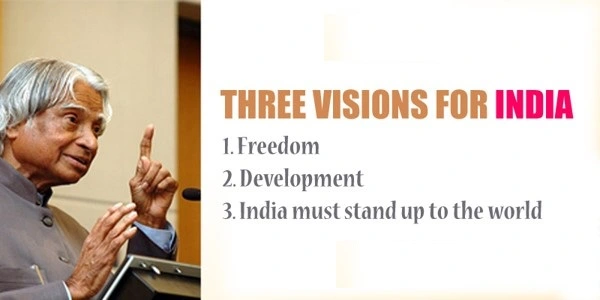Summary
Dr. APJ Abdul Kalam (1931-2015) was one of India’s most inspiring and beloved personalities, often called the People’s President and Missile Man of India. Born in a humble family in Rameswaram, Tamil Nadu, he rose to great heights through hard work and determination. As a scientist, he played a crucial role in developing India’s first satellite launch vehicle and missile programs. He served as the 11th President of India from 2002 to 2007, during which he connected deeply with citizens, especially young people. He was not just a scientist and statesman, but also an author, writing influential books. He remained humble and dedicated to inspiring the youth to dream big and work for India’s development.
He gave an important speech called I Have Three Visions for India at IIT, Hyderabad. In this speech, he shared his dreams about how India could become better in the future. These ideas were so important that he later included them in his book Ignited Minds. As someone who worked for many years in science and as President, Dr. Kalam explained three main hopes he had for India’s growth. His words inspire both, young and old people because he believed strongly in what India could achieve. I Have Three Visions for India has main points in simple terms are follows:
The three visions he discussed were:
1. Freedom
* Kalam believed India needed complete freedom – not just political independence, but freedom from poverty, social problems, and corruption.
* He emphasized that less than 1% of Indians had made it to higher education at that time
* He stressed that education and economic growth were key to achieving true freedom
2. India’s Development
* He wanted India to become a fully developed nation
* Focused on the need to grow India’s economy and improve quality of life
* Emphasized the importance of technology and innovation in development
* Believed India needed to strengthen its agriculture, industry, and technology sectors
3. Standing Tall in the World
* Wanted India to be respected globally as a strong nation
* Emphasized that India should be self-reliant and confident
* Believed India should contribute significantly to the world’s progress
* Wanted India to be known for its strength, not its weaknesses
Throughout the speech entitled I Have Three Visions for India, Kalam stressed that achieving these visions required:
* Hard work and dedication from all citizens
* Focus on education and skill development
* Unity among all Indians
* Pride in Indian culture while embracing modern technology
Positive thinking and action
His message was optimistic and action-oriented, encouraging Indians to work together to build a better future for their country.
Multiple Choice Questions
1. In which year Dr. Kalam was born?
a) 1929
b) 1930
c) 1931
d) 1932
2. What political designation did Dr. Kalam hold?
a) President
b) Prime Minister
c) Chief Minister
d) Governor
3. What is the second vision outlined by Dr. Kalam in his speech?
a) Freedom
b) Independence
c) Development
d) Financial Growth
4. Out of the following, what is India the largest producer in the World?
a) Coffee
b) Wheat
c) Rice
d) Milk
5. Where did Dr. Kalam deliver this famous lecture?
a) IIT, Kharagpur
b) IIT, Hyderabad
c) IIM, Lucknow
d) IIM, Kolkata
6. In which year Dr. Kalam deliver this lecture?
a) 2010
b) 2011
c) 2012
d) 2013
7. How many years did he spend in ISRO?
a) 10
b) 15
c) 20
d) 25
8. Which famous personality does he quote in the end?
a) Nelson Mandela
b) Che Guevara
c) Abraham Lincoln
d) JF Kennedy
9. How many core visions did Dr. Kalam present for India in his speech?
a) Two
b) Three
c) Four
d) Five
10. According to Dr. Kalam's speech, what percentage of Indians had access to higher education at that time?
a) Less than 1%
b) Less than 5%
c) Less than 10%
d) Less than 15%
11. Which type of freedom did Dr. Kalam emphasize beyond political independence?
a) Freedom from foreign influence
b) Freedom from taxation
c) Freedom from poverty and corruption
d) Freedom from tradition
12. What did Dr. Kalam identify as key factors for achieving true freedom?
a) Military power and defence
b) Education and economic growth
c) International relations
d) Cultural preservation
13. Which sectors did Dr. Kalam emphasize for India's development?
a) Agriculture, industry, and technology
b) Sports, entertainment, and tourism
c) Mining, fishing, and forestry
d) Banking, insurance, and finance
14. What was Dr. Kalam's vision for India's global standing?
a) To be feared by other nations
b) To be financially dependent
c) To be respected and self-reliant
d) To be isolated from world affairs
15. Which approach did Dr. Kalam advocate for India's progress?
a) Negative criticism
b) Passive acceptance
c) Positive thinking and action
d) Competitive aggression
16. What did Dr. Kalam identify as essential for achieving his visions?
a) Individual success only
b) Government initiatives only
c) Foreign investment only
d) Unity among all Indians
17. How did Dr. Kalam suggest India should approach modernization?
a) Reject all traditions
b) Maintain pride in culture while embracing modern technology
c) Focus only on technological advancement
d) Preserve tradition by avoiding modern technology
18. What was the primary tone of Dr. Kalam's speech?
a) Critical and pessimistic
b) Neutral and analytical
c) Optimistic and action-oriented
d) Defensive and cautious
19. What is Dr. Kalam's first vision for India?
a) Development
b) Freedom
c) Military power
d) Economic growth
20. What is the growth rate mentioned in most areas according to the passage?
a) 5 percent
b) 7 percent
c) 10 percent
d) 15 percent
21. Which three great minds did Dr. Kalam mention working with?
a) Dr. Vikram Sarabhai, Professor Satish Dhawan, Dr. Brahm Prakash
b) Dr. C.V. Raman, Dr. Homi Bhabha, Dr. Vikram Sarabhai
c) Professor Satish Dhawan, Dr. Homi Bhabha, Dr. Brahm Prakash
d) Dr. Vikram Sarabhai, Dr. Homi Bhabha, Professor Satish Dhawan
22. What was the goal of the 14-year-old girl mentioned in the passage?
a) To become a scientist
b) To get an autograph
c) To live in a developed India
d) To meet Dr. Kalam
23. According to the passage, where was India ranked in terms of GDP?
a) Top 3
b) Top 5
c) Top 10
d) Top 15
24. What does Dr. Kalam emphasize must go hand-in-hand?
a) Freedom and development
b) Military power and economic power
c) Education and technology
d) Culture and modernization
25. What historical fact does Dr. Kalam mention about India's relationship with other nations?
a) India has never conquered other nations
b) India has always been peaceful
c) India has been a global leader
d) India has dominated trade
26. According to the text, who are mentioned among those who came and invaded India?
a) Romans, Greeks, French
b) Greeks, Turks, Moguls
c) Vikings, Dutch, Portuguese
d) Arabs, Persians, British
Brief Answer Type Questions
- What are the three visions Dr. Kalam had for India?
- What are the four milestones of Dr. Kalam’s career?
- What kinds of bliss did Dr. Kalam experience, as outlined by the speech?
- What is duplicity of Indian behaviour when it come to our country as opposed to visiting another country?
- What are our expectations from India-run companies?
- Why do we forfeit responsibility after voting in elections?
- Why does the system need to change?
Write Short Notes
- The influence of media on public opinion
- Our excuse to not engage in raging social issues
- Our country’s expectations from us
References:
John, Annie, et al., editors, Gems of Wisdom. Macmillan Publishers India Pvt. Ltd. Chennai, 2017.


1 thought on “I Have Three Visions for India”